

Science Notebooking. How to Teach Students Note Taking Skills - Abundant Life. Photo Credit Competent note taking is one of those study skills that students are rarely taught in high schools.
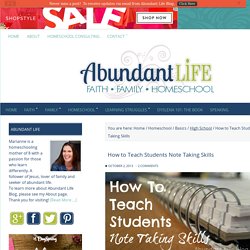
I, like many others, learned note-taking the hard way by the sink or swim method in college. As my older kids get closer and closer to finishing high school and heading out to the world of the college lecture hall, I have been researching exactly how to teach them this valuable skill. This post will list several different ways to learn to take notes but there is really no substitute for practice. Taking good notes – notes that will be useful for studying from later – require that the note taker evaluate, organize and then succinctly summarize the information being presented. Science Notebooks - Keystone Area Education Agency. Home » Curriculum, Instruction, and Assessment » Science » Science Notebooks Science Notebooks Getting Started With Science Notebooks Sometimes all it takes to get students excited about using science notebooks is to look at a few examples from real life.
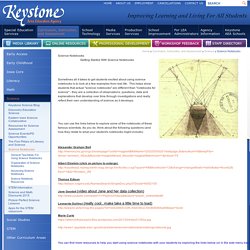
This helps show students that actual "science notebooks" are different than "notebooks for science" - they are a collection of observations, questions, data and explanations that develop over time through investigations and really reflect their own understanding of science as it develops. You can use the links below to explore some of the notebooks of these famous scientists. Alexander Graham Bell Albert Einstein (click on picture to enlarge) Thomas Edison Jane Goodall (video about Jane and her data collection)
Is Notebooking Right for Your Child? Meet Some Famous Notebookers! Welcome!

If you're interested in discipling children for Christ, I'd love to have you subscribe to Thinking Kids. Also, please follow me on Pinterest where I've compiled a library of discipleship and homeschool resources for you. Thinking Kids posts contain affiliate links. You can find out more about those on the disclosure page. Uterus of a Cow, 1508, Leonardo Da Vinci (1452-1519), Public Domain The Reason We Notebook. Interactive Notebooks.
My students are 14-18 years old and enrolled in math or physics for the first or second time.
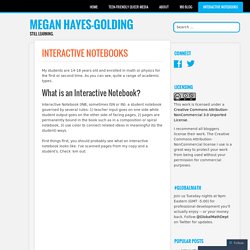
As you can see, quite a range of academic types. Interactive Notebook (INB, sometimes ISN or IN): a student notebook governed by several rules: 1) teacher input goes on one side while student output goes on the other side of facing pages, 2) pages are permanently bound in the book such as in a composition or spiral notebook, 3) use color to connect related ideas in meaningful (to the student) ways. First things first, you should probably see what an interactive notebook looks like. I’ve scanned pages from my copy and a student’s. Assignments - MrRoughton.com. Rubric Cover Sheets How To Instructions Below you will find links to and descriptions of all the assignments we use for Choose Your Own Adventure.
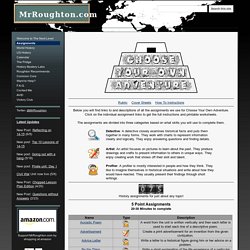
Click on the individual assignment links to get the full instructions and printable worksheets. The assignments are divided into three categories based on what skills you will use to complete them. History assignments for just about any topic! 5 Point Assignments20-30 Minutes to complete. Assignment-table.pdf. Interactive-notebook-presentation.pdf. Lesson 1: Setting up the ISN. Introduction Now that you have examined exactly what an Interactive Student Notebook is, your first step in learning to implement the strategy in your classroom seems relatively simple: learn and show students how to set up an ISN.
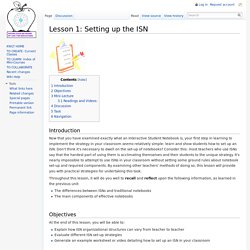
Don't think it's necessary to dwell on the set-up of notebooks? Consider this: most teachers who use ISNs say that the hardest part of using them is acclimating themselves and their students to the unique strategy. It's nearly impossible to attempt to use ISNs in your classroom without setting some ground rules about notebook set-up and required components. By examining other teachers' methods of doing so, this lesson will provide you with practical strategies for undertaking this task. Throughout this lesson, it will do you well to recall and reflect upon the following information, as learned in the previous unit: The differences between ISNs and traditional notebooks The main components of effective notebooks Objectives Mini-Lecture Readings and Videos: Reflect.
Interactive Notebook- Introduction and set-up. Interactive-notebooks - home. Everybody is a Genius: Interactive Notebooks. If you haven't already, read this and this.
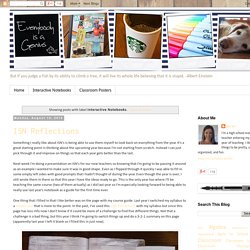
All caught up? Ok great. I didn't get too specific with lesson plans, but I did give my kids a general outline for their lesson. They needed a do now, their rule and the explanation behind it, an ISN page, practice and assessment. I'll break down what they did into these categories. Oh let me also say that I wish I took more pictures. They all did a do now. Interactive Notebooking - AP Biology and Biology 2013-2014. Science Notebooks. California Classroom Science » Taking the Interactive Science Notebook Plunge. Posted: Tuesday, August 5th, 2014 by Jill Grace I kept hearing about it for years.

THE NOTEBOOK. It sounded interesting, it had good research street cred, everyone seemed to rave about it, BUT…I was intimidated. What is up with the input-output stuff? It wasn’t until one particular bunch of kids in one particular school year that I realized I NEEDED to take the plunge. This article is intended to give you some extra advice on finally jumping in with both feet. Did I mention: IT IS WORTH IT! Here are a few reasons why I think it’s worth taking the plunge: The IN model uses a dual page format where one page is the input (where students get info from reading, video, observations, lecture, etc.) and the other is the output (where they make sense of that input).
Parent: So, Mrs. Yes, ladies and gentlemen, the IN page says it all.